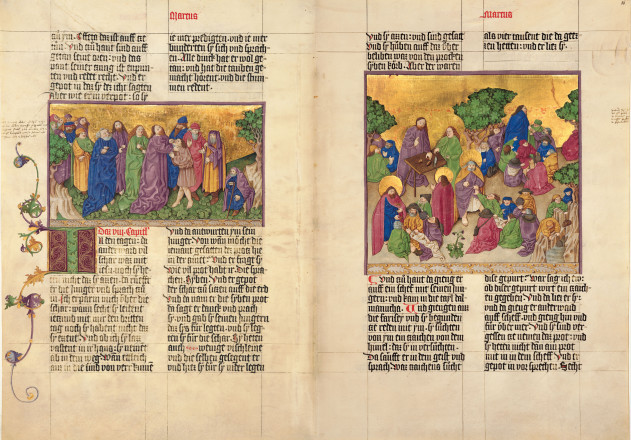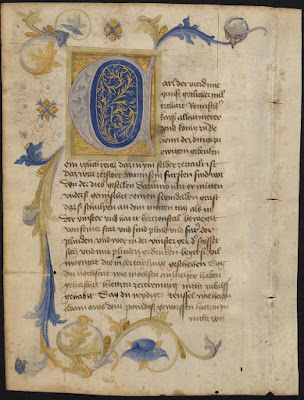 |
| Emperor Sigismund and the Electors, German-language copy of the Golden Bull of Charles IV Stadtarchiv Ulm A Urk. Ve. 1356 Januar 10, fol. 1v |
At an exhibition held last year at Neuburg an der Donau, the chief work in focus was a 15th-century Bible, the Ottheinrich Bible. Regarded as the earliest surviving illustrated manuscript of the New Testament in the German language, it was originally commissioned around 1430 by Ludwig VII, the Bearded, Duke of Bavaria-Ingolstadt. It was illuminated by three Regensburg painters, but its decoration remained unfinished - only to be completed by the artist Mathis Gerung in 1530–31. The manuscript was later split up into eight volumes, and after a rather complicated history, now all of its parts are at the Bavarian State Library in Munich - on their website, you can browse the digitized volumes of the Bible.
The exhibition, titled Kunst und Glaube, contained lots of interesting objects, as far as I can tell based on the catalogue. I was most interested in objects dating from the period of Ludwig VII of Bavaria (Duke of Bavaria-Ingolstadt between 1413-1447), a contemporary of King and Emperor Sigismund, and a noted patron of the arts. Perhaps the most well-known of his commissions is the small-scale model of this tombstone, made by Hans Multscher around 1435 (Munich, Bayerisches Nationalmuseum). This tomb was never executed in full size. The Ottheinrich Bible was also one of his important commissions, which remained unfinished.
 |
| Double page from the Ottheinrich Bible, c. 1430 (vol. 2.) |
One of the objects in this section was a fragmentary manuscript of the Golden Bull of Charles IV, which was illuminated by the workshop of the Ottheinrich Bible (the so-calle Matthäusmaler). The manuscript was executed in Regensburg, and its surviving fragment is kept at the Town Archives of Ulm (See catalogue record). The fragment was identified as dating from this period by professor Robert Suckale, who provided a study about the Ottheinrich Bible for the catalogue (and also contributed to the catalogue entry in question, cat. no. 5.18). The fragment consists of only three leafs, containing a German translation of the Golden Bull issued in 1356. On the verso of the first folio, a group portrait of the Holy Roman Emperor with the Electors is depicted (see above). As Sigismund was also the King of Bohemia from 1419, only six Electors are depicted around the Emperor. On fol. 2r, the fragment also includes the full page depiction of coat of arms of a certain Hans Kastenmayer of Straubing - an image very similar to those included on armorial letters issued by the imperial chancery at that time, and the fragment also contains a nice initial.
 |
| Decorated page of the Ulm fragment |

